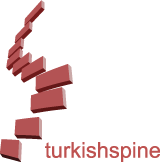ABSTRACT
Object:
Transarticular C1-2 fixation is a surgical alternative in the treatment of atlantoaxial instability. To clarify the present incidence and management of iatrogenic vertebral artery injury (VAI) during cervical spine surgery. The majority of spine surgeons prefer to perform posterior fixation for C1-2 instability. Our hypotheses are that posterior transarticular screw fixation is enough for stabilization and it may result in vascular injury. Vertebral artery injury during posterior C1-2 transarticular screw fixation occurs in approximately 3 % of patients and may remain asymptomatic or result in arteriovenous fistulae, occlusion, narrowing, or dissection of the vertebral artery, and lead to transient ischemic attacks, stroke, or death
Method:
During a period of 6 years (2003- 2009), transarticular C1/2 fixation was performed in 20 patients. All were followed-up for 10–35 months (average 24.1 months) and were included in this retrospective study. The average age was 49.2 years (range 12–75 years). Atlantoaxial fusion was required in 9 (45 %) patients for an acute injury to the upper cervical spine, in 5 (25 %) patients with rheumatoid arthritis for atlantoaxial vertical instability, in 1 (5 %) patient for malunion of the old fractured dens, and in 5 (25 %) patients for os odontoideum.. Retrospectively, we evaluated age; gender; diagnosis; preoperative neurological status; technique of surgery; operative time; intraoperative blood loss; interval of X-ray exposure; placement, direction and length of the screws used; relation between vertebral artery and the screws; postoperative neurological outcome; vascular and other postoperative complications; follow-up time and fusion time. The post-operative condition was subjectively evaluated by patients. The relation between vertebral artery (VA) and the screws was detected by postoperative computed tomography (CT). Stability of the temporary fixation was evaluated on radiographs taken at 3, 12 weeks and 6 and 24 months after the surgery. Monitoring of postoperative complications was focused on vertebral artery injury, delayed healing of the wound, breaking or loosening of screws and development of instability.
Results:
Operative time was 35 to 155 min, (average 83 min). Intraoperative blood loss ranged from 80 to 220 ml (average 155 ml). A total of 40 transarticular screws were inserted into the C1-2, screw lengths ranged from 45 to 50 mm (average, 47 mm). In 4 cases the screws were combined another vertebral segment such as CO, C1 and C3. In this series, neither vertebral artery injury nor spinal cord injury was experienced clinically. In our series the risk of vertebral artery injury was 0%. The risk of minor breach of vertebral foramen was 10 %. The mortality rate was 0 %. The fusion was observed in all cases (100 %). Only 2 (10 %) screws protruded into the transverse foramen. C1–C2 stability was achieved in all patients. We observed postoperative dermal cerebrospinal fluid fistules in 2 (10 %) patients.
Conclusion:
Bilateral transarticular posterior screws have excellent clinical results without VA injury. The risk of catastrophic vascular or neural injury is small and can be minimized by assessing the position of the foramen transversaria on preoperative computed tomographic scans and by using intraoperative fluoroscopy.



